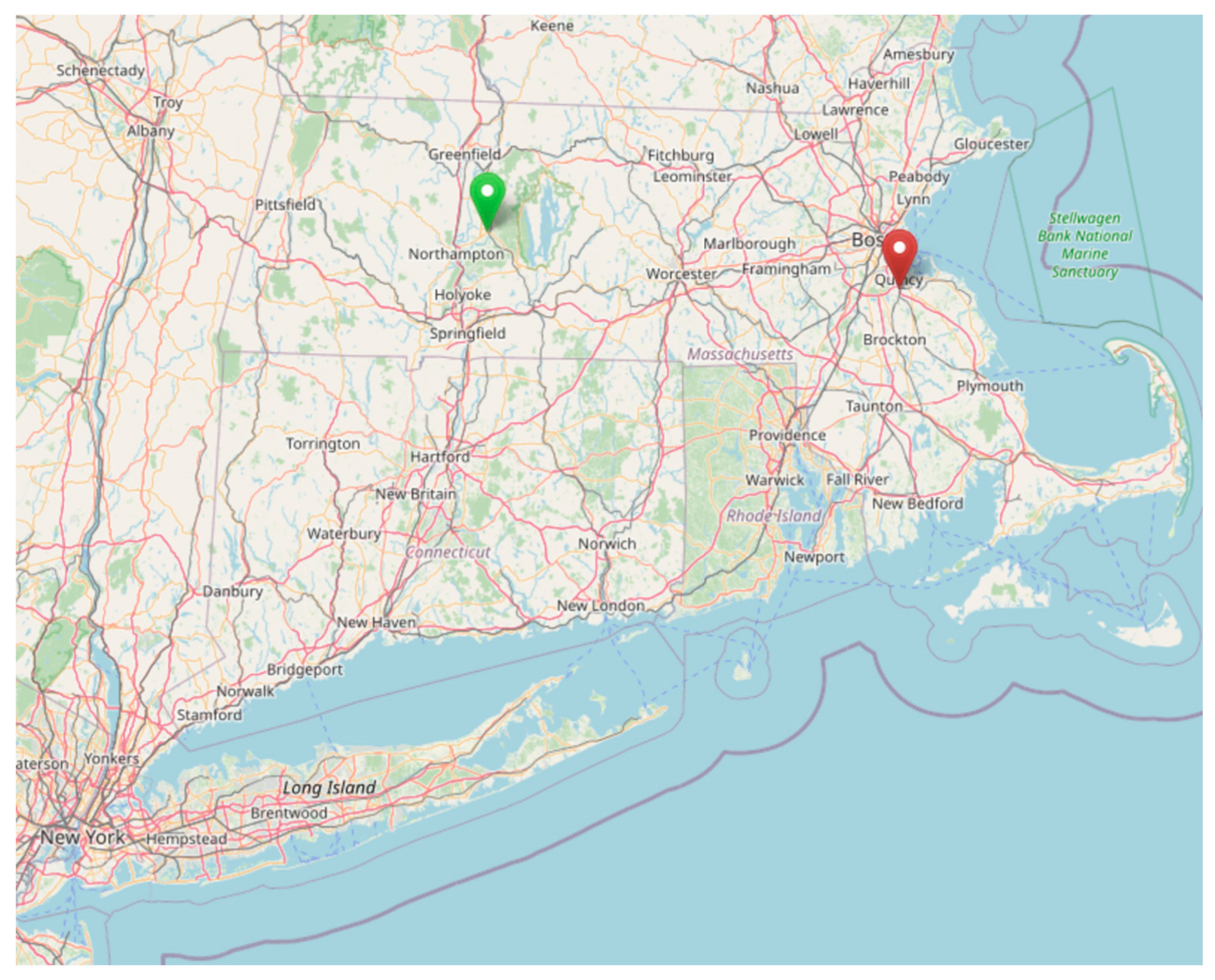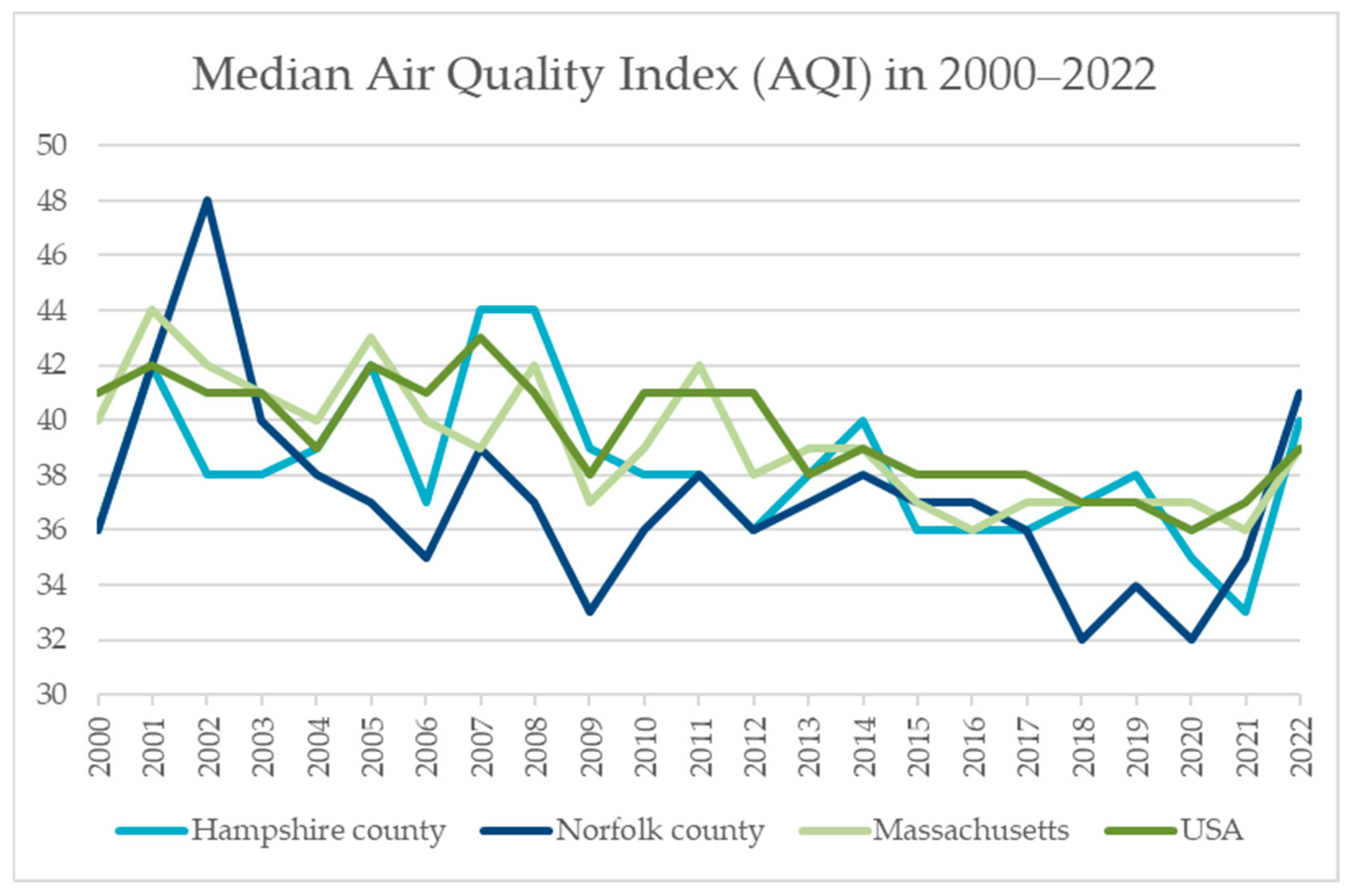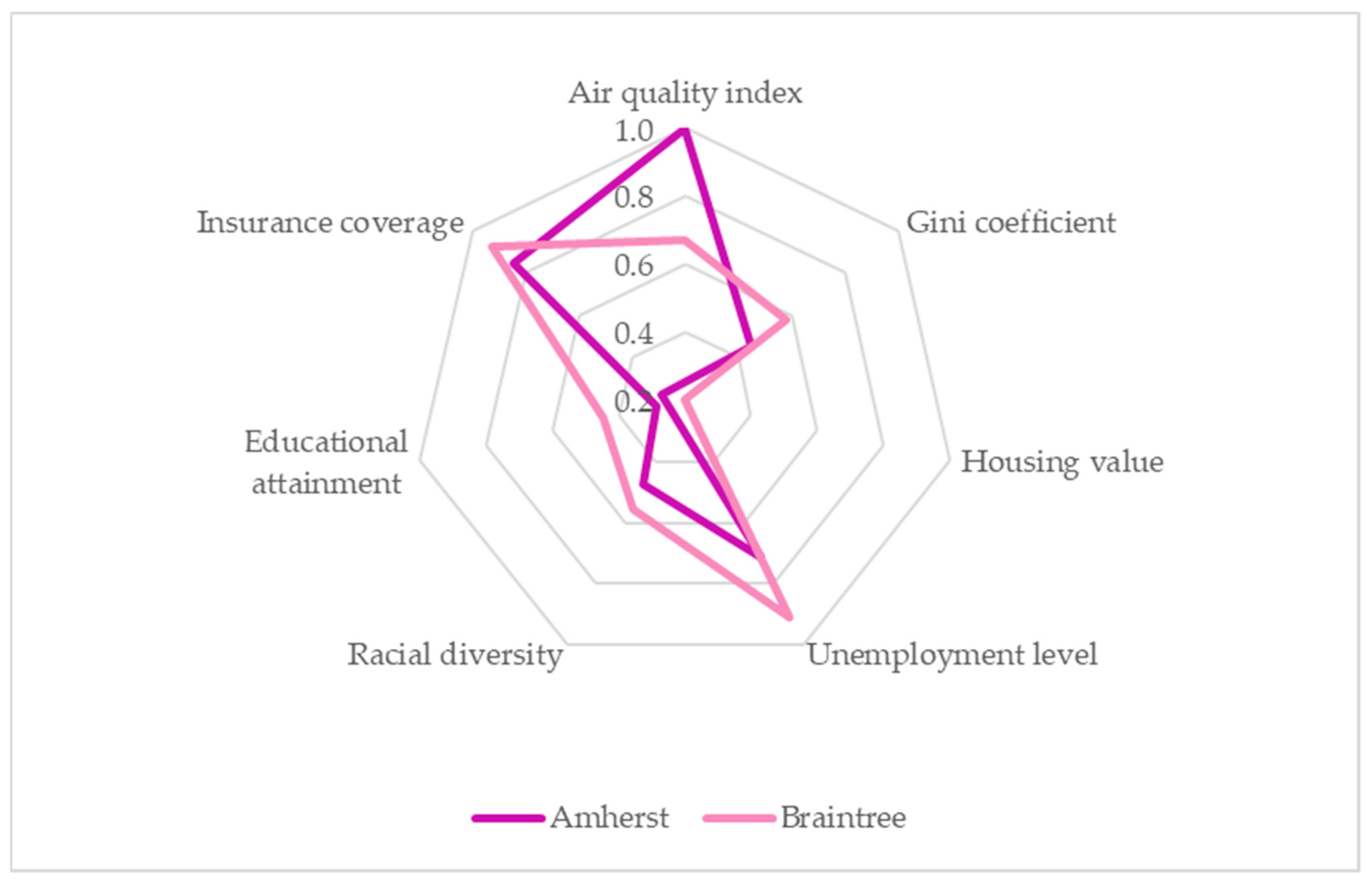Evaluating the Economic Sustainability of Two Selected Urban Centers—A Focus on Amherst and Braintree, MA, USA
Abstract
1. Introduction
2. Economic Sustainability and Its Attributes
3. Developing City Economic Sustainability Index
4. Environment
- a.
- Ground-level ozone;
- b.
- Particle pollution (also known as particulate matter, including PM2.5 and PM10);
- c.
- Carbon monoxide;
- d.
- Sulfur dioxide;
- e.
- Nitrogen dioxide [38].
- 1.
- Identify the highest concentration among all the monitors within each reporting area and truncate as follows:
- a.
- Ozone (ppm)—truncate to three decimal places;
- b.
- PM2.5 (µg/m3)—truncate to one decimal place;
- c.
- PM10 (µg/m3)—truncate to an integer;
- d.
- CO (ppm)—truncate to one decimal place;
- e.
- SO2 (ppb)—truncate to an integer, NO2 (ppb), and truncate to an integer.
- 2.
- Using the AQI Technical Assistance Document, find the two breakpoints that contain the concentration. The document can be read in [38], p. 9.
- 3.
- Calculate the AQI for each pollutant using the following formula:where AQIp is the AQI index for pollutant p, Cp is the truncated concentration of pollutant p, BPhigh is the concentration breakpoint that is greater than or equal to Cp, BPlow is the concentration breakpoint that is less than or equal to Cp, AQIhigh is the AQI value corresponding to BPhigh, and AQIlow is the AQI value corresponding to BPlow.
- 4.
- The final value of the AQI index is the maximum value among all AQIp.
5. Economy
6. Society
7. Economic Sustainability Index (USCESI)
8. Results
9. Conclusions
Author Contributions
Funding
Institutional Review Board Statement
Informed Consent Statement
Data Availability Statement
Conflicts of Interest
References
- Boar, A.; Bastida, R.; Marimon, F. A Systematic Literature Review. Relationships between the Sharing Economy, Sustainability and Sustainable Development Goals. Sustainability 2020, 12, 6744. [Google Scholar] [CrossRef]
- Davies, A. Economic Sustainability: Concepts and Indicators; Economic Series; Annals of Spiru Haret University: Bucharest, Romania, 2009; pp. 87–98. [Google Scholar]
- Hardisty, P.E. Environmental and Economic Sustainability; CRC Press: Boca Raton, FL, USA, 2010; p. 337. [Google Scholar]
- Jeronen, E. Economic Sustainability. In Encyclopedia of Sustainable Management; Idowu, S., Schmidpeter, R., Capaldi, N., Zu, L., Del Baldo, M., Abreu, R., Eds.; Springer: Cham, Switzerland, 2020; ISBN 978-3-030-02006-4. [Google Scholar]
- Spangenberg, J.H. Economic sustainability of the economy: Concepts and indicators. Int. J. Sustain. Dev. 2005, 8, 47. [Google Scholar] [CrossRef]
- Gaubert, C.; Kline, P.; Vergara, D.; Yagan, D. Trends in US Spatial Inequality: Concentrating Affluence and a Democratization of Poverty. AEA Pap. Proc. 2021, 111, 520–525. [Google Scholar] [CrossRef]
- Hanley, C. A Spatial Perspective on Rising Inequality in the United States. Int. J. Sociol. 2010, 40, 6–30. [Google Scholar] [CrossRef]
- Goal 3: Ensure Healthy Lives and Promote Well-Being for All at All Ages. Available online: https://www.un.org/sustainabledevelopment/health/ (accessed on 1 November 2023).
- Dolan, P.; Peasgood, T.; White, M. Review of Research on the Influences on Personal Well-Being and Application to Policy Making; Defra: London, UK, 2006. [Google Scholar]
- O’Mahony, T. Toward Sustainable Wellbeing: Advances in Contemporary Concepts. Front. Sustain. 2022, 3, 807984. [Google Scholar] [CrossRef]
- Stiglitz, J.E.; Sen, A.; Fitoussi, J.P. Report by the Commission on the Measurement of Economic Performance and Social Progress; Commission on the Measurement of Economic Performance and Social Progress: Paris, France, 2009. [Google Scholar]
- Schrock, G.; Bassett, E.M.; Green, J. Pursuing Equity and Justice in a Changing Climate: Assessing Equity in Local Climate and Sustainability Plans in U.S. Cities J. Plan. Educ. Res. 2015, 35, 282–295. [Google Scholar] [CrossRef]
- Angelidou, M. Smart city policies: A spatial approach. Cities 2014, 41, 3–11. [Google Scholar] [CrossRef]
- Caragliu, A.; Del Bo, C.; Nijkamp, P. Smart Cities in Europe. J. Urban Technol. 2011, 18, 65–82. [Google Scholar] [CrossRef]
- Russ, M.; Bansal, G.; Parrillo, A. The “Knowledge City” and the “Experience City”: The Main, Mediating, and Moderating Effects of Education on Income and Economic Inequality. J. Knowl. Econ. 2017, 8, 804–829. [Google Scholar] [CrossRef]
- Apple, M. Comparing neo-liberal projects and inequality in education. Comp. Educ. 2001, 37, 409–423. [Google Scholar] [CrossRef]
- Mettler, S. Degrees of Inequality: How the Politics of Higher Education Sabotaged the American Dream; Basic Books: New York, NY, USA, 2014. [Google Scholar]
- Bernstein, R.S.; Bulger, M.; Salipante, P.; Weisinger, J.Y. From Diversity to Inclusion to Equity: A Theory of Generative Interactions. J. Bus. Ethics 2020, 167, 395–410. [Google Scholar] [CrossRef]
- Craig, M.A.; Rucker, J.M.; Richeson, J.A. The Pitfalls and Promise of Increasing Racial Diversity: Threat, Contact, and Race Relations in the 21st Century. Curr. Dir. Psychol. Sci. 2018, 27, 188–193. [Google Scholar] [CrossRef]
- Florida, R. The New Urban Crisis: Gentrification, Housing Bubbles, Growing Inequality, and What We Can Do About It; Simon and Schuster: New York, NY, USA, 2017; p. 337. [Google Scholar]
- Swope, C.B.; Hernández, D. Housing as a determinant of health equity: A conceptual model. Soc. Sci. Med. 2019, 243, 112571. [Google Scholar] [CrossRef] [PubMed]
- Wuerzer, T. Urban Health. In Encyclopedia of Quality of Life and Well-Being Research; Michalos, A.C., Ed.; Springer: Dordrecht, The Netherlands, 2014. [Google Scholar] [CrossRef]
- Merzel, C.; Moon-Howard, J. Access to health services in an urban community: Does source of care make a difference? J. Urban. Health 2002, 79, 186–199. [Google Scholar] [CrossRef] [PubMed][Green Version]
- Anderson Ron, J.M.D.; Boumbulian Paul, J. DPA, MPH.; Pickens, S Sue MEd. The Role of U.S. Public Hospitals in Urban Health. Acad. Med. 2004, 79, 1162–1168. [Google Scholar] [CrossRef]
- Cyr, M.E.; Etchin, A.G.; Guthrie, B.J.; Benneyan, J.C. Access to specialty healthcare in urban versus rural US populations: A systematic literature review. BMC Health Serv. Res. 2019, 19, 974. [Google Scholar] [CrossRef]
- Angier, H.; Ezekiel-Herrera, D.; Marino, M.; Hoopes, M.; Jacobs, E.A.; DeVoe, J.E.; Huguet, N. Racial/Ethnic Disparities in Health Insurance and Differences in Visit Type for a Population of Patients with Diabetes after Medicaid Expansion. J. Health Care Poor Underserved 2019, 30, 116–130. [Google Scholar] [CrossRef]
- Beltrán, S.; Arenas, D.J.; López-Hinojosa, I.J.; Tung, E.L.; Cronholm, P.F. Associations of Race, Insurance, and Zip Code-Level Income with Nonadherence Diagnoses in Primary and Specialty Diabetes Care. J. Am. Board Fam. Med. 2021, 34, 891–897. [Google Scholar] [CrossRef]
- Hao, S.; Snyder, R.A.; Irish, W.; Parikh, A.A. Correction: Association of race and health insurance in treatment disparities of colon cancer: A retrospective analysis utilizing a national population database in the United States. PLoS Med. 2022, 19, e1003937. [Google Scholar] [CrossRef]
- Tiba, S.; Omri, A. Literature survey on the relationships between energy, environment and economic growth. Renew. Sustain. Energy Rev. 2017, 69, 1129–1146. [Google Scholar] [CrossRef]
- Guest, R. The economics of sustainability in the context of climate change: An overview. J. World Bus. 2010, 45, 326–335. [Google Scholar] [CrossRef]
- Economic Sustainability—An Overview. Available online: https://www.sciencedirect.com/topics/engineering/economic-sustainability (accessed on 5 September 2023).
- Mohammed, S.; Vaardini, U.S. Analysis on the Growing Problems of E-waste and Implementation of a Circular Economic Approach to Managing E-waste. In Proceedings of the 2021 International Conference on Advancements in Electrical, Electronics, Communication, Computing and Automation (ICAECA), Coimbatore, India, 8–9 October 2021; IEEE: Piscataway, NJ, USA, 2021; pp. 1–5. [Google Scholar]
- Six, L.; Velghe, F.; Verstichel, S.; De Meester, S. Sustainability Considerations on the Valorization of Organic Waste. In Biotransformation of Agricultural Waste and By-Products: The Food, Feed, Fibre, Fuel (4F) Economy; Poltronieri, P., D’Urso, O., Eds.; Elsevier Inc.: Amsterdam, The Netherlands, 2016; pp. 287–296. [Google Scholar] [CrossRef]
- Our Common Future. Available online: http://www.un-documents.net/ocf-02.htm (accessed on 5 September 2023).
- Purvis, B.; Mao, Y.; Robinson, D. Three pillars of sustainability: In search of conceptual origins. Sustain. Sci. 2019, 14, 681–695. [Google Scholar] [CrossRef]
- Air Quality Index Report. Available online: https://www.epa.gov/outdoor-air-quality-data/air-quality-index-report (accessed on 5 September 2023).
- NHGIS Data Finder. Available online: https://data2.nhgis.org/main (accessed on 5 September 2023).
- Technical Assistance Document for the Reporting of Daily Air Quality—The Air Quality Index (AQI). Available online: https://www.airnow.gov/sites/default/files/2020-05/aqi-technical-assistance-document-sept2018.pdf (accessed on 5 September 2023).
- AQI Basics. Available online: https://www.airnow.gov/aqi/aqi-basics/ (accessed on 5 September 2023).
- Myrdal, K.G. An American Dilemma: The Negro Problem and Modern Democ-racy; Harper & Bros: New York, NY, USA, 1944; p. 360. [Google Scholar]
- Myrdal, K.G. Rich Lands and Poor: The Road to World Prosperity; Harper & Row: New York, NY, USA, 1957; p. 168. [Google Scholar]
- Pini, P. Economic Growth, Technological Change and Employment, Empirical Evidence for a Cumulative Growth Model with External Causation for Nine OECD Countries: 1960–1990. Struct. Change Econ. Dyn. 1995, 6, 185–213. [Google Scholar] [CrossRef]
- Berger, S.; Elsner, W. European Contributions to Evolutionary Institutional Economics: The Cases of Cumulative Circular Causation (CCC) and Open Systems Approach (OSA)—Some Methodological and Policy Implications. J. Econ. Issues 2007, 41, 529–537. [Google Scholar] [CrossRef]
- Fujita, N. Myrdal’s Theory of Cumulative Causation. Evol. Institutional Econ. Rev. 2007, 3, 275–284. [Google Scholar] [CrossRef]
- Westlund, H. Gunnar Myrdal (1898–1987): Cumulative Causation Theory Applied to Regions. In Great Minds in Regional Science. Footprints of Regional Science; Batey, P., Plane, D., Eds.; Springer: Cham, Switzerland, 2020. [Google Scholar] [CrossRef]
- Alichi, A.; Kantenga, K.; Sole, J. Income Polarization in the United States; International Monetary Fund: Washington, DC, USA, 2016; p. 36. ISBN 1475522509/9781475522501. [Google Scholar]
- Hoffmann, F.; Lee, D.S.; Lemieux, T. Growing Income Inequality in the United States and Other Advanced Economies. J. Econ. Perspect. 2020, 34, 52–78. [Google Scholar] [CrossRef]
- Frank, M.W. Inequality And Growth In The United States: Evidence From A New State-Level Panel of Income Inequality Measures. Economic Inquiry. West. Econ. Assoc. Int. 2009, 47, 55–68. [Google Scholar] [CrossRef]
- Olson, M.E.; Diekema, D.; Elliott, B.A.; Renier, C.M. Impact of Income and Income Inequality on Infant Health Outcomes in the United States. Pediatrics 2010, 126, 1165–1173. [Google Scholar] [CrossRef]
- Schettino, F.; Khan, H.A. Income polarization in the USA: What happened to the middle class in the last few decades? Struct. Change Econ. Dyn. 2020, 53, 149–161. [Google Scholar] [CrossRef]
- Barreca, A.; Curto, R.; Rolando, D. Urban Vibrancy: An Emerging Factor that Spatially Influences the Real Estate Market. Sustainability 2020, 12, 346. [Google Scholar] [CrossRef]
- Conceptual modeling of the paradigm of the land market sustainable and harmonious development Natalia Mikhailovna Stiazhkova, Iuliia Olegovna Smirnova and Vitalii Aleksandrovich Lukinov. E3S Web Conf. 2023, 403, 01017. [CrossRef]
- Vlasova, N.; Shishkina, E. Real estate market as an indicator of urban sustainable development Ivan Antipin. E3S Web of Conf. 2023, 451, 02006. [Google Scholar] [CrossRef]
- Fitzgerald, J. Emerald Cities: Urban Sustainability and Economic Development; Oxford University Press: Oxford, UK, 2010; p. 256. [Google Scholar]
- Grodach, C. Barriers to sustainable economic development: The Dallas-Fort Worth experience. Cities 2011, 28, 300–309. [Google Scholar] [CrossRef]
- Ismail, S. Sustainability as Opportunity and the Problem of Social Capital. Brown J. World Aff. 1996, 3, 187–203. Available online: https://www.jstor.org/stable/24590148 (accessed on 22 November 2023).
- Selman, P. Social Capital, Sustainability and Environmental Planning. Plan. Theory Pract. 2001, 2, 13–30. [Google Scholar] [CrossRef]
- Helliwell, J.F.; Putnam, R.D. Education and Social Capital. East. Econ. J. 2007, 33, 1–19. Available online: https://www.jstor.org/stable/20642328 (accessed on 22 November 2023). [CrossRef]
- Hero, R. Social Capital and Racial Inequality in America. Perspect. Politics 2003, 1, 113–122. [Google Scholar] [CrossRef]
- Williams, J. Health Insurance in an Era of Declining Social Capital. World Aff. 2020, 183, 343–358. [Google Scholar] [CrossRef]
- Lu, F.; Rosser, R.H.; Renteria, A.; Kim, N.; Erickson, E.; Sher, A.; O’Connor, L. Inclusive Sustainability: Environmental Justice in Higher Education. In Handbook of Sustainability and Social Science Research; Leal Filho, W., Marans, R., Callewaert, J., Eds.; World Sustainability Series; Springer: Cham, Switzerland, 2018. [Google Scholar] [CrossRef]
- Alkon, A.H.; Agyeman, J. Cultivating Food Justice: Race, Class, and Sustainability; MIT Press: Cambridge, MA, USA, 2011; p. 404. [Google Scholar]
- Schroeder, K.; Thompson, T.; Frith, K.; Pencheon, D. Sustainable Healthcare; John Wiley & Sons: Hoboken, NJ, USA, 2012; p. 280. [Google Scholar]
- Human Development Report Office. Available online: http://hdr.undp.org/ (accessed on 5 September 2023).
- Spitsin, V.; Vuković, D.B.; Akerman, E.; Borilo, L.; Chistyakova, N. Regional issue, innovation, and the ecological footprint. J. Geogr. Inst. Jovan Cvijić SASA 2023, 73, 221–236. [Google Scholar] [CrossRef]




| Indicator | Assessment Dimension | Source |
|---|---|---|
| Air Quality Index (AQI) | Environment | [36] |
| Gini Coefficient | Economy | [37] |
| Housing Value | Economy | [37] |
| Unemployment Level | Economy | [37] |
| Racial Diversity | Society | Calculated by the authors based on the data [37] |
| Educational Attainment | Society | [37] |
| Insurance Coverage | Society | [37] |
| Levels of Concern | Values of AQI | Description of Air Quality |
|---|---|---|
| Good | 0 to 50 | Air quality is satisfactory, and air pollution poses little or no risk. |
| Moderate | 51 to 100 | Air quality is acceptable. However, there may be a risk for some people, particularly those who are unusually sensitive to air pollution. |
| Unhealthy for Sensitive Groups | 101 to 150 | Members of sensitive groups may experience health effects. The general public is less likely to be affected. |
| Unhealthy | 151 to 200 | Some members of the general public may experience health effects; members of sensitive groups may experience more serious health effects. |
| Very Unhealthy | 201 to 300 | Health alert: The risk of health effects is increased for everyone. |
| Hazardous | 301 and higher | Health warning of emergency conditions: everyone is more likely to be affected. |
Disclaimer/Publisher’s Note: The statements, opinions and data contained in all publications are solely those of the individual author(s) and contributor(s) and not of MDPI and/or the editor(s). MDPI and/or the editor(s) disclaim responsibility for any injury to people or property resulting from any ideas, methods, instructions or products referred to in the content. |
© 2024 by the authors. Licensee MDPI, Basel, Switzerland. This article is an open access article distributed under the terms and conditions of the Creative Commons Attribution (CC BY) license (https://creativecommons.org/licenses/by/4.0/).
Share and Cite
Alov, I.N.; Petrović, M.D.; Belyaeva, A.M. Evaluating the Economic Sustainability of Two Selected Urban Centers—A Focus on Amherst and Braintree, MA, USA. Sustainability 2024, 16, 925. https://doi.org/10.3390/su16020925
Alov IN, Petrović MD, Belyaeva AM. Evaluating the Economic Sustainability of Two Selected Urban Centers—A Focus on Amherst and Braintree, MA, USA. Sustainability. 2024; 16(2):925. https://doi.org/10.3390/su16020925
Chicago/Turabian StyleAlov, Ivan N., Marko D. Petrović, and Alisa M. Belyaeva. 2024. "Evaluating the Economic Sustainability of Two Selected Urban Centers—A Focus on Amherst and Braintree, MA, USA" Sustainability 16, no. 2: 925. https://doi.org/10.3390/su16020925
APA StyleAlov, I. N., Petrović, M. D., & Belyaeva, A. M. (2024). Evaluating the Economic Sustainability of Two Selected Urban Centers—A Focus on Amherst and Braintree, MA, USA. Sustainability, 16(2), 925. https://doi.org/10.3390/su16020925






